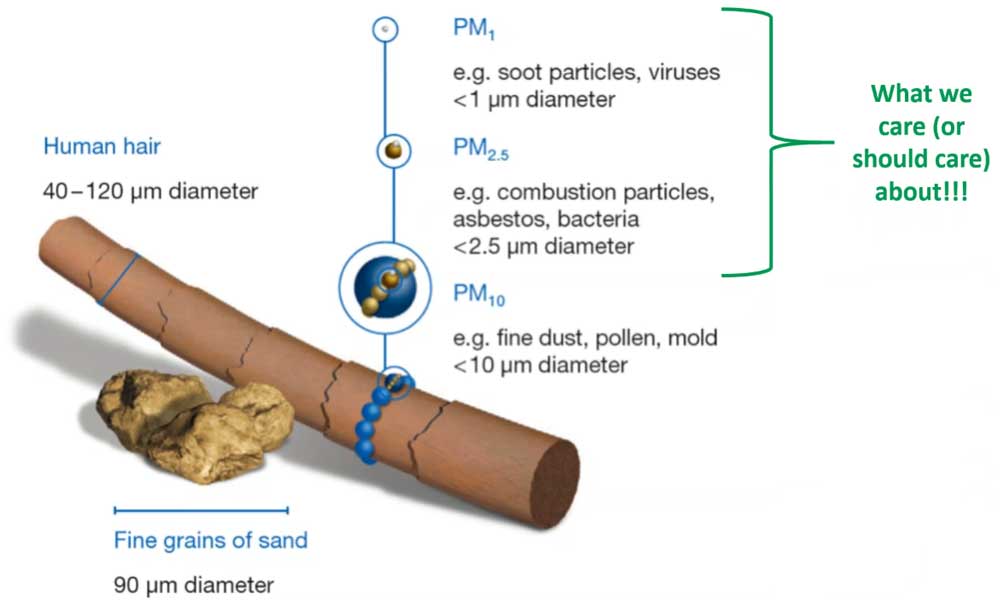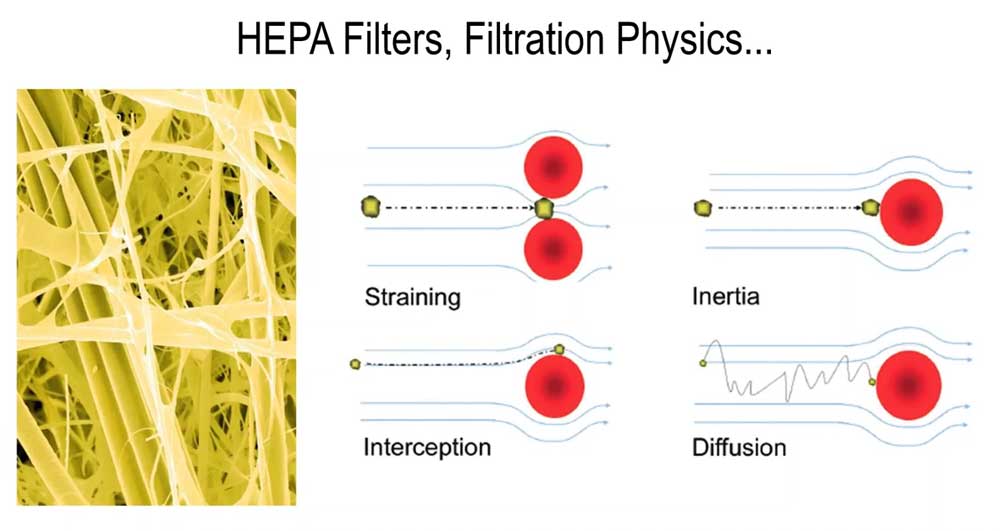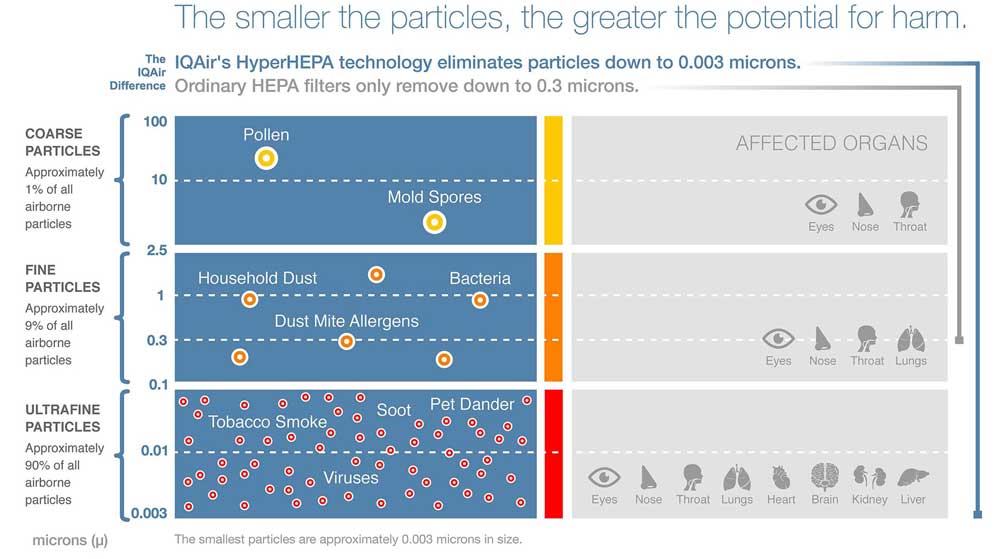When looking for a suitable air purifier, you’ll come across terms like True HEPA and HEPA-type filters. While both filters are mechanical and quite effective in cleaning your indoor air of airborne contaminants, they vary in density, pricing, and more importantly, filtration efficiency.
HEPA filters originated with United States military for protection against chemical, biological, and radiological warfare agents and to avoid emission from nuclear facilities. HEPA filter was commercialized in 1960s to be sold to public.
Here is a detailed description of the two filters, including their working mechanism.
- What Is a HEPA Filter?
- What is a Micron?
- How are Filters Tested?
- How Do True HEPA Filters Work?
- Do All HEPA Filters Have the Same Efficiency?
- What is a HEPA-Type Filter?
- What is MERV?
- How Do I Tell which Filter is in the Air Purifier?
What Is a HEPA Filter?
HEPA is an acronym for High-Efficiency Particulate Air, as defined by DOE. It meets the highest testing standard for a filter’s efficiency in eliminating airborne pollutants.
For a filter to qualify as a ‘True HEPA filter,’ it must trap 99.97% of particulates as small as 0.3 microns. These particulates fall under the Most Penetrating Particle Size (MMPS), due to their ability to pass through most filters. A True HEPA filter can trap tiny airborne contaminants like pet dander, mold spores, pollen, dust mites, viruses, and bacteria with utmost efficiency.
Tip: A True HEPA filter can trap more or even smaller particles than the set threshold.
What is a Micron?
A micron is a particle whose length equals one-millionth of a meter. To get a better understanding of just how tiny a micron is, remember that you cannot see anything that’s less than 40 microns with your naked eyes.

How are Filters Tested?
The efficiency of filters is tested according to the methodologies provided by the Recommended Practices (RP). These recommendations are published by the Institute of Environmental Sciences and Technologies (IEST).
During the test, particles or aerosols of specific sizes are passed through the filter. Its ability to prevent the particulates from passing through is thereby recorded. The results are subsequently provided on a label, specifying the filter’s efficiency in percentage form and the size of particles it can trap.
How Do True HEPA Filters Work?
True HEPA filters are made of a complex web of fibers intertwined to create a fibrous maze.
As the air goes through a standard True HEPA filter, the particles are trapped in the following ways:
Inertia
This stage traps larger and heavier particle pollutants like dust, mold spores, pollen, lint, and hair. The principles of inertia coupled with the rapid changes in air direction to separate airborne particulates from the air stream. This technique works best in the presence of a high concentration of course contaminants and serves as a pre-filtration mode for the successive higher efficiency filters.
Interception
At this stage, the second largest particles are trapped. These particles are usually small enough to go through the inertial impaction but get stuck to the filter media upon making physical contact.
Diffusion
The smallest particles travel more erratically than the larger ones. As they travel, they collide against each other and end up entangled in the nearby fibers.

Do All HEPA Filters Have the Same Efficiency?
As mentioned earlier, a filter must meet the 99.97% air cleaning threshold and be able to trap pollutants as small as 0.3 microns to qualify as a True HEPA filter. You will, however, find True-HEPA filters that are more efficient than others.
The classification of True HEPA filters ranges from H10-H12, both of which extract 85-99.5% of pollutants as small as 0.1 microns. You’ll also find H13 AND H14, which are considered medical-grade and are capable of eliminating microns as small as 0.1 with an efficiency of 99.95% and 99.995%, respectively.

Pro Tip: Generally, as the number after letter H increases, the higher the filter’s efficiency.
What is a HEPA-Type Filter?
HEPA-Type or HEPA-Like is a term used to refer to highly efficient filters that trap smaller and more particles than your conventional filters. These filters are, however, less efficient than True HEPA filters. HEPA-Type filters have 99% or less efficiency and are typically capable of trapping particulates as small as two microns.
Due to their high-efficiency rating that surpasses ordinary filters, HEPA-Type filters come at a greater price. As such, you may confuse them with True-HEPA filters, which is wrong as HEPA-like filters are less dense and allow finer particles to pass through.
Tip: While HEPA-Type filters lack a HEPA rating, they come with a MERV rating.
What is MERV?
MERV symbolizes Minimum Efficiency Reporting Values; it’s tasked with establishing a filter’s capacity to arrest particles measuring between 0.3 and 10 microns. This rating helps with comparing the performance of different filters. MERV ratings are sourced from a testing method developed by the American Society of Heating, Refrigerating, and Air Conditioning Engineers (ASHRAE).
The common MERV ratings tell you how efficient your filter is in trapping airborne pollutants on a scale of 1 to 16. Filters with the lowest efficiency have a MERV rating of 1-4. These filters can trap pollutants measuring between 3.0 -10 microns with a 20% efficiency.
Filters boasting the highest efficiency have a MERV rating of 16. These can trap pollutants measuring 0.3-1.0 microns with a 75% efficiency or even more. Some boast an impressive 99% efficiency.
You may also find filters with a MERV rating of 17 to 20. These are suitable for environments requiring absolute cleanliness, including operation rooms.
Tip: As the MERV rating increases, so does the filter’s efficacy.
How Do I Tell which Filter is in the Air Purifier?
You can determine the type of filter in your air purifier by reading the specifications in the unit’s package before making your purchase. If you are in a physical store, check the box label or go through the user manual.
If you need a True-HEPA, ensure that it has a minimum efficiency of 99.97% and can extract particles as small as 0.3 microns, regardless of the name given to the filter. If it’s lesser than that, then it’s a HEPA-Type filter.
The Bottom Line
The main difference between a True-HEPA filter and a HEPA-Type filter is the efficiency in trapping airborne pollutants. From the precedent, it’s apparent that a true HEPA filter is more efficient than a HEPA-Type filter. However, the two are applicable in different situations, making their existence a necessity.
True-HEPA filters will give their HEPA-Type counterparts a run for their money when it comes to efficient elimination of the smallest airborne contaminants. However, HEPA-Type filters boast a competitive edge due to their low pricing.
True-HEPA filters are a bit expensive, but they come in handy in areas where a high level of filtration is needed. True-HEPA filters are also used in hospitals, schools, and industries due to the regulatory requirements in such buildings. They’re also the best choice for homes, given that indoor airborne pollutants are deadlier than those found outdoors.
- In a nutshell, if a filter doesn’t have a MERV or HEPA rating, it’s not worth buying.
